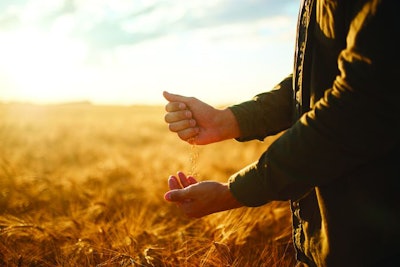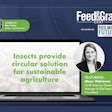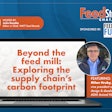
How the utilization of ingredients not fit for human consumption in animal feed improves the sustainability of food systems
In food systems, circularity is a model where waste is minimized and a closed-loop system is created where all resources are used efficiently and sustainably. In this paradigm, waste from one stage of the food supply chain is repurposed as a resource for another stage, creating a continuous cycle of use and reuse.
When it comes to animal feed, a circular-economic approach involves the utilization of waste from food processing and other industries to create feed ingredients. These repurposed foodstuffs provide a cost-effective alternative to traditional, resource-intensive raw materials like corn and soybeans. Here, animal feed helps create a more sustainable and resilient food system by minimizing waste and maximizing the use of available resources.
Dr. Cliff Adams, the founder and managing director of Anozene Nutritional Sciences and author of the book “Feeding animals is essential for global food security,” joined the Chat to look at feed’s role in a circular economy and future raw material opportunities in animal feeding.
Circularity in food systems: Feed’s role in achieving zero waste from WATT Global Media on Vimeo.
Transcription of Feed Strategy Chat with Dr. Cliff Adams, founder and managing director, Anozeme Nutritional Sciences
Jackie Roembke, editor in chief, WATT Feed Brands/Feed Strategy: Hi, everyone. Welcome to Feed Strategy Chat. I’m your host, Jackie Roembke, editor in chief of WATT Feed Brands and Feed Strategy magazine.
This edition of Feed Strategy Chat is brought to you by WATT Global Media and FeedStrategy.com. FeedStrategy.com is your source for the latest news and leading-edge analysis of the global animal feed industry.
Today we’re joined on Zoom by Dr. Cliff Adams, the founder and managing director of Anozene Nutritional Sciences. He has worked in the feed additive industry for 25 years, and has recently authored the book, “Feeding animals is essential for global food security.”
He’s here today to discuss feed’s role in the circular economy. Hi, Dr. Adams, how are you?
Cliff Adams: Oh, fine. Thank you. Nice to be on the program.
Roembke: Happy to have you. Well, let’s get right into it. When we talk about the circular economy as relates to food systems, what does this entail and how is it connected to sustainability?
Adams: Well the concept of the circular economy is that you minimize the inputs, maximize outputs, and reuse as much material as possible to minimize waste. And this is really what we’re doing in the in the animal feed business, of course, is we’re bringing in inputs from different areas, generating high-quality food and trying to minimize the waste.
Also, this goes further on into general food management and handling because, unfortunately, an enormous amount of food is wasted, and a part of the circular economy. We also need to work with people on an individual basis to reduce food waste, which we can also then perhaps add better value from the inputs that we have to make the food in the first place.
Roembke: Great, thank you for that brief explanation. Now, please delve into animal feed’s role in circularity, and also provide a few examples and practical applications.
Adams: A large amount of the food resources on this planet are not edible directly for humans. We only eat a small proportion of the plant forms that are provided, most of them are turned on a waste product or byproducts, which we then utilize to feed animals to generate more food for humans. So the whole point of the animal feed industry is that we’re converting a large amount of non-edible food products, non-edible for humans, into high-quality food products. And these foods could not otherwise be utilized. Humans cannot eat them. We don’t eat a straw. We don’t eat grass. We don’t eat soybean meal. But, on the other hand, animals do and this then converts them into a very good source of human food.
Roembke: What are the near-term obstacles that producers face in playing an optimal role in the circular economy?
Adams: I don’t think that there are many obstacles for the feed industry because we’ve already developed very efficient use of an enormous range of feed ingredients, many of which are not edible for humans. So the short term is not a big issue, longer term, there is a problem. Perhaps because of the availability of some of the materials today might not be available in the future, and then we’ll need to bring in other materials.
Roembke: Are there any novel ingredients that you think are particularly promising?
Adams: Well, yeah, I think there’s quite a few. There’s a lot of activity nowadays into looking at things like seaweeds, insects, wood processing, there’s a huge amount of material still out there, which is not widely used in animal nutrition, but in the future I think to come into use in animal nutrition.
There’s already a very substantial investment in insect production. Now, insect protein is highly nutritious and very suitable for animal production. And also, we can do a lot perhaps with bypassing from wood and straw, these other materials can be further processed, perhaps with newer developments to get better value from these.
I think, in the future, we have a long way to go, but a lot we can do to bring in new sources of feed ingredients.
Roembke: How may these systems advance in the future? Describe some of these potential outcomes.
Adams: Well, I think the example if we get into large-scale production of insect protein, this is highly nutritious for animals. The amino acid makeup is very good, that digestibility is very good.
I think we’re going to have a good potential source of alternative raw materials. We can also process, hopefully, more of the cellulose-based materials. This can also be applied into the biofuels industry as well as animal feed, because there’s a big interest now in trying to develop cellulosic or cellulose-based fermentation methods to produce ethanol. For example, if this comes in, we can have access to a whole new source of raw materials. There’s an enormous amount of cellulose-based materials out there, which is difficult to use.
Roembke: Before we wrap up, is there anything else that you’d like to emphasize or any main points from your book?
Adams: Yeah, I think we need to get a whole wider understanding of the necessity and the value of feeding animals, because a large proportion of the food resources on this planet cannot be directly eaten by humans. And in order to utilize these materials efficiently, we have to feed into animals. And unfortunately, this is often not realized. So I think it’s a very important issue for public education, to explain to people that feeding animals is a way to utilize more efficiently, the food resources that we have on this planet.
Roembke: Very good. Thank you so much for your time today. For more information about the book and some of the things that Dr. Adams spoke about today, please visit Anozene Nutritional Sciences at www.anozene.eu.
Thank you so much, Dr. Adams, and thanks to you for tuning in.

















